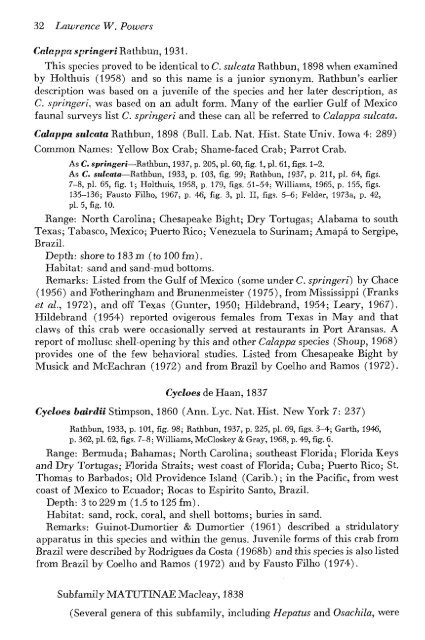You also want an ePaper? Increase the reach of your titles
YUMPU automatically turns print PDFs into web optimized ePapers that Google loves.
32 Lawrence W. Powers<br />
Calappa springeriVia\hhun, 1931.<br />
This species proved to be identical to C. sulcata Rathbun, 1898 when examined<br />
by Holthuis (1958) and so this name is a junior synonym. Rathbun's earlier<br />
description was based on a juvenile of the species and her later description, as<br />
C. springeri, was based on an adult form.. Many of the earlier Gulf of Mexico<br />
faunal surveys list C. springeri and these can all be referred to Calappa sulcata.<br />
Calappa sulcata Rathbun, 1898 (Bull. Lab. Nat. Hist. State Univ. Iowa 4: 289)<br />
Common Names: Yellow Box Crab; Shame-faced Crab; Parrot Crab.<br />
As C. sprmgeri—Rathbun, 1937, p. 205, pi. 60, fig. 1, pi. 61, figs. 1-2.<br />
As C. sa/c«l«—Rathbun, 1933, p. 103, fig. 99; Rathbun, 1937, p. 211, pi. 64, figs.<br />
7-8, pi. 65, fig. 1; Holthuis, 1958, p. 179, figs. 51-54; Williams, 1965, p. 155, figs.<br />
135-136; Fausto Filho, 1967, p. 46, fig. 3, pi. II, figs. 5-6; Felder, 1973a, p. 42,<br />
pi. 5, fig. 10.<br />
Range: North Carolina; Chesapeake Bight; Dry Tortugas; Alabama to south<br />
Texas; Tabasco, Mexico; Puerto Rico; Venezuela to Surinam; Amapa to Sergipe,<br />
Brazil.<br />
Depth: shore to 183 m (to 100 fm).<br />
Habitat: sand and sand-mud bottoms.<br />
Remarks: Listed from the Gulf of Mexico (some under C. springeri) by Chace<br />
(1956) and Fotheringham and Brunenmeister (1975), from Mississippi (Franks<br />
et al, 1972), and off Texas (Gunter, 1950; Hildebrand, 1954; Leary, 1967).<br />
Hildebrand (1954) reported ovigerous females from Texas in May and that<br />
claws of this crab were occasionally served at restaurants in Port Aransas. A<br />
report of mollusc shell-opening by this and other Calappa species (Shoup, 1968)<br />
provides one of the few behavioral studies. Listed from Chesapeake Bight by<br />
Musick and McEachran (1972) and from Brazil by Coelho and Ramos (1972).<br />
Cycloes de Haan, 1837<br />
Cycloes bairdii Stimpson, 1860 (Ann. Lye. Nat. Hist. New York 7: 237)<br />
Rathbun, 1933, p. 101, fig. 98; Rathbun, 1937, p. 225, pi. 69, figs. 3-4; Garth, 1946,<br />
p. 362, pi. 62, figs. 7-8; Williams, McCloskey & Gray, 1968, p. 49, fig. 6.<br />
V<br />
Range: Bermuda; Bahamas; North Carolina; southeast Florida; Florida Keys<br />
and Dry Tortugas; Florida Straits; west coast of Florida; Cuba; Puerto Rico; St.<br />
Thomas to Barbados; Old Providence Island (Carib.); in the Pacific, from west<br />
coast of Mexico to Ecuador; Rocas to Espirito Santo, Brazil.<br />
Depth: 3 to 229 m (1.5 to 125 fm).<br />
Habitat: sand, rock, coral, and shell bottoms; buries in sand.<br />
Remarks: Guinot-Dumortier & Dumortier (1961) described a stridulatory<br />
apparatus in this species and within the genus. Juvenile forms of this crab from<br />
Brazil were described by Rodrigues da Costa (1968b) and this species is also listed<br />
from Brazil by Coelho and Ramos (1972) and by Fausto Filho (1974).<br />
Subfamily MATUTINAE Macleay, 1838<br />
(Several genera of this subfamily, including Hepatus and Osachila, were

















